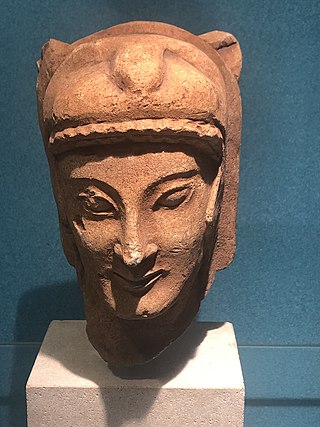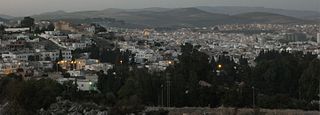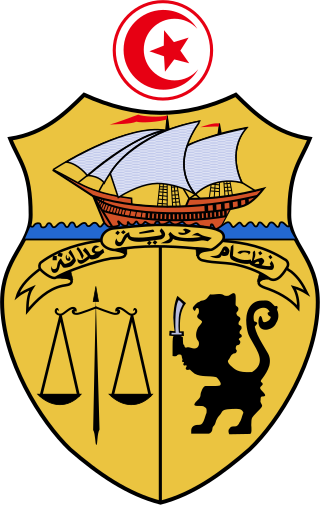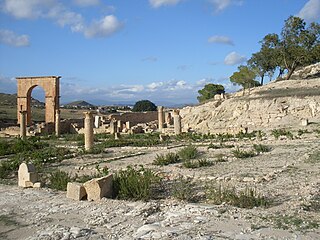
Carthage was the capital city of ancient Carthage, on the eastern side of the Lake of Tunis in what is now Tunisia. Carthage was one of the most important trading hubs of the Ancient Mediterranean and one of the most affluent cities of the classical world.

Tunis is the capital and largest city of Tunisia. The greater metropolitan area of Tunis, often referred to as "Grand Tunis", has about 2,700,000 inhabitants. As of 2020, it is the third-largest city in the Maghreb region and the eleventh-largest in the Arab world.

Melqart was the tutelary god of the Phoenician city-state of Tyre and a major deity in the Phoenician and Punic pantheons. Often titled the "Lord of Tyre", he was also known as the Son of Baal or El, King of the Underworld, and Protector of the Universe. He symbolized the annual cycle of vegetation and was associated with the Phoenician maternal goddess Astarte.

Utica was an ancient Phoenician and Carthaginian city located near the outflow of the Medjerda River into the Mediterranean, between Carthage in the south and Hippo Diarrhytus in the north. It is traditionally considered to be the first colony to have been founded by the Phoenicians in North Africa. After Carthage's loss to Rome in the Punic Wars, Utica was an important Roman colony for seven centuries.

Béja is a city in Tunisia. It is the capital of the Béja Governorate. It is located 105 kilometers (65 mi) from Tunis, between the Medjerdah River and the Mediterranean, against the foothills of the Khroumire, the town of Béja is situated on the sides of Djebel Acheb, facing the greening meadows, its white terraces and red roofs dominated by the imposing ruins of the old Roman fortress.

The Medjerda River, the classical Bagrada, is a river in North Africa flowing from northeast Algeria through Tunisia before emptying into the Gulf of Tunis and Lake of Tunis. With a length of 450 km (280 mi), it is the longest river of Tunisia. It is also known as the Wadi Majardah or Mejerha.

Ghar el-Melh, the classical Rusucmona and Castra Delia and colonial Porto Farina, is a town and former port on the southern side of Cape Farina in Bizerte Governorate, Tunisia.

La Marsa La Marsa is a coastal city located in the northeastern part of Tunisia, situated along the Mediterranean Sea. It is part of the Tunis Governorate and has a population of around 100,000 people. The city is known for its beautiful beaches, upscale residential areas, and lively atmosphere, with numerous restaurants, cafes, and shops.It is connected to Tunis by the TGM railway. Gammarth is adjacent to El Marsa further up the coast.

Cape Bon, also known as Ras at-Taib, Sharīk Peninsula, or Watan el Kibli, is a peninsula in far northeastern Tunisia. Cape Bon is also the name of the northernmost point on the peninsula, also known as Ras ed-Dar, and known in antiquity as the Cape of Mercury or Cape Hermaeum.

The Punic religion, Carthaginian religion, or Western Phoenician religion in the western Mediterranean was a direct continuation of the Phoenician variety of the polytheistic ancient Canaanite religion. However, significant local differences developed over the centuries following the foundation of Carthage and other Punic communities elsewhere in North Africa, southern Spain, Sardinia, western Sicily, and Malta from the ninth century BC onward. After the conquest of these regions by the Roman Republic in the third and second centuries BC, Punic religious practices continued, surviving until the fourth century AD in some cases. As with most cultures of the ancient Mediterranean, Punic religion suffused their society and there was no stark distinction between religious and secular spheres. Sources on Punic religion are poor. There are no surviving literary sources and Punic religion is primarily reconstructed from inscriptions and archaeological evidence. An important sacred space in Punic religion appears to have been the large open air sanctuaries known as tophets in modern scholarship, in which urns containing the cremated bones of infants and animals were buried. There is a long-running scholarly debate about whether child sacrifice occurred at these locations, as suggested by Greco-Roman and biblical sources.

The Punic people, or Carthaginians, were a Semitic people in the Western Mediterranean who migrated from Tyre, Phoenicia to North Africa during the Early Iron Age. In modern scholarship, the term Punic, the Latin equivalent of the Greek-derived term Phoenician, is exclusively used to refer to Phoenicians in the western Mediterranean, following the line of the Greek East and Latin West.

The delegations of Tunisia are the second level administrative divisions of Tunisia between the governorates and the sectors (imadats). As of 2006 there were 24 governorates which were divided into 264 delegations and further divided into 2073 sectors. The delegations are listed below, organized by governorate.

The following outline is provided as an overview of and topical guide to Tunisia:

Azeffoun, the classical Rusazus and colonial Port Gueydon, is a town and commune in Tizi Ouzou Province in northern Algeria, located on Cape Corbelin 64 km (40 mi) north-east of Tizi Ouzou. The economy of the town of Azeffoun is based on tourism, fishing, and agriculture.
Tunisia, officially the Tunisian Republic, is the northernmost country in Africa. It is a Maghreb country and is bordered by Algeria to the west, Libya to the southeast, and the Mediterranean Sea to the north and east. Its area is almost 165,000 square kilometres (64,000 sq mi), with an estimated population of just over 10.4 million. Its name is derived from the capital Tunis located in the north-east.
Usta Murad was a corsair captain and later Dey of Tunis from 1637 until his death.

Pheradi Majius is a locality and archaeological site in Tunisia located at 36.250003°N 10.397047°E near the modern town of Sidi Khalifa in Sousse Governorate, Tunisia that is located at 36° 14′ 58″ N, 10° 23′ 57″E.

Sidi Khelifa is a Tunisian village located near the town of Bouficha on the Mediterranean coastal plain, about 100 kilometers south of Tunis.
Usta Murad Mosque, was a Tunisian mosque located in the medina of Tunis. It does not exist anymore.

Plane Island also known as Piana or Plana Island and—in Tunisian Arabic—as Jaziret el-Monbasta, is a flat, rocky island in the Mediterranean Sea roughly 3.75 kilometers (2.3 mi) off Cape Farina, Tunisia. It has a lighthouse.






















